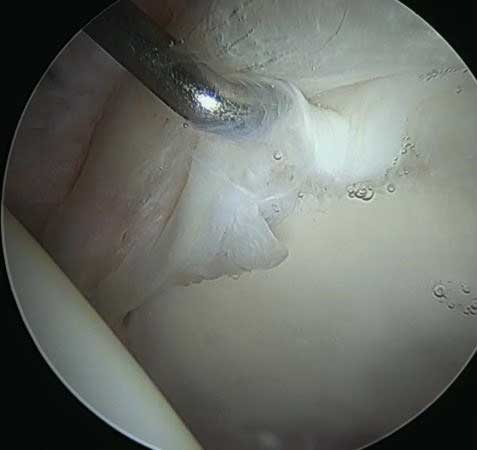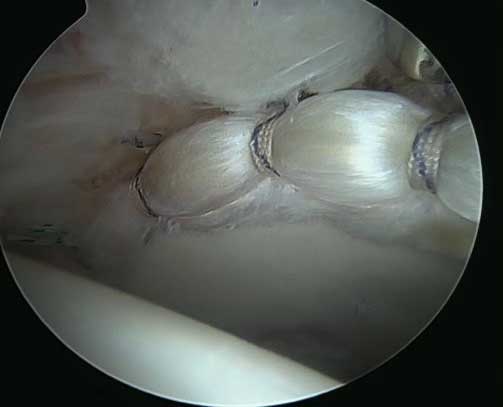Hip Injuries
Personalized Care for Lasting Relief
Femoroacetabular Impingement
Learn more about types of FAI (Femoroacetabular Impingement), presentation and treatment.
Schedule an appointment with Dr. Robert Browning for FAI Evaluation online or give us a call at (803) 256-4107.
Hip Arthroscopy
Learn more about types of Hip Arthroscopy, presentation and treatment.
Schedule an appointment with Dr. Robert Browning for Hip Arthroscopy Evaluation online or give us a call at (803) 256-4107.
Proximal Hamstring Tear
Learn more about types of Proximal Hamstring Tear, presentation and treatment.
Schedule an appointment with Dr. Robert Browning for Proximal Hamstring Tear Evaluation online or give us a call at (803) 256-4107.
Greater Trochanteric Pain Syndrome
Learn more about types of GTPS (Greater Trochanteric Pain Syndrome), presentation and treatment.
Schedule an appointment with Dr. Robert Browning for Greater Trochanteric Pain Syndrome Evaluation online or give us a call at (803) 256-4107.
Hip Injury Specialist: Robert Browning, M.D.
Femoroacetabular Impingement (FAI)
Hip Anatomy
- The normal hip is a congruent ball and socket joint
- The femoral head (ball) rotates on the acetabulum (socket) to achieve full hip range of motion
- Cartilage lines the ball and the socket to reduce friction between the bones
- The labrum cushions the joint but also acts like a rubber seal or gasket to help hold the ball securely within the socket
Watch this video for more information about hip anatomy
What is Femoroacetabular Impingement (FAI)?
- FAI occurs when there is a mismatch between the ball (femur) and the socket (acetabulum)
- Impingement (abnormal contact) occurs when this mismatch within the hip joint leads to cartilage and labrum damage
- Damage to cartilage and the labrum leads to pain, decreased function, and increased risk of progression to arthritis
FAI Presentation
- Ages 15-55
- Active Individuals
- Females > Males
- Patients typically complain of:
- Pain in the groin, buttock, and/or lateral side of the hip
- Pain with running, squatting, prolonged sitting, etc.
- Decreased range of motion
- Decreased strength or endurance
Watch this video for more information about FAI.
Watch this video for more information about labral tears.
Types of FAI
Pincer Impingement
- The acetabulum (socket) is too deep or facing backwards (retroverted) which prevents the ball from clearing the socket during hip movement
- Damage occurs when the femur collides into the overhanging rim of the socket which may lead to labral tearing
Cam Impingement
- The femoral head (ball) is not completely round
- The non-round ball rotates into the round socket which may lead to cartilage damage and labral tearing
Mixed or Combined
- Elements of both cam and pincer
FAI Treatment
Key Concepts
- Not all patients with FAI on x-ray will become symptomatic and require treatment
- Many people with FAI have similar x-ray findings on the other hip but do not have symptoms
- The goal of treatment is to decrease pain and increase function by reducing inflammation and optimizing hip and pelvis mechanics
Non-operative Treatment for FAI
- Rest and avoiding painful activities alone may improve symptoms
- Anti-inflammatory medicines (Advil, Aleve, etc.) and cortisone injections can decrease pain and inflammation
- Physical therapy is essential for improvement in hip and pelvis mechanics and mobility
- Non-operative treatment for patients with FAI is often successful and can avoid the need for surgery
Hip Arthroscopy for Treatment of FAI
- Hip arthroscopy, also referred to as keyhole or minimally invasive surgery, is typically necessary for cases that do not improve with conservative treatment
- The goal of hip arthroscopy is to correct the bony abnormality causing impingement and repair the damage to the labrum and cartilage
- Traction is used to increase space within the joint
- 3 poke-hole incisions are made to place a small video camera and specialized instruments into the hip joint
- Patients return home the same day after surgery
- Patients are on crutches for 3-4 weeks
- Full recovery takes 5 to 6 months and requires PT to restore optimal hip function
- About 1 in 3 patients eventually undergo hip arthroscopy on the other side
- Hip arthroscopy is not effective in patients with arthritis or severe dysplasia
Watch this video for more information about hip arthroscopy for FAI
Labral Repair: Anchors are used to fix the torn labrum
Hip Injury Specialist: Robert Browning, M.D.
Hip Arthroscopy
What is Hip Arthroscopy?
- Hip arthroscopy, also referred to as keyhole or minimally invasive hip surgery, is typically necessary for hip pain that does not improve with conservative treatment
- Small incisions are made only big enough to place a small video camera and specialized instruments into the hip joint, trochanteric space, and/or ischial space to clearly diagnose and treat hip pathology
Watch this video for more information about Hip Arthroscopy.
Common Conditions Treated with Hip Arthroscopy
Femoroacetabular Impingement (FAI): Cam deformity, Pincer deformity
Proximal Hamstring Tear, Gluteus Medius Tear, Snapping Hip
Ischiofemoral Impingement, Loose bodies
Watch this video for more information on Hip Arthroscopy for FAI.
Is Hip Arthroscopy right for me?
- Hip conditions often improve with conservative treatment including a short course of rest, anti-inflammatory pain medication, and physical therapy. An ultrasound guided cortisone injection is sometimes necessary for patients with persistent pain.
- If pain continues despite conservative treatment, hip arthroscopy is an excellent treatment option for patients with labral tears, femoroacetabular impingement (FAI), tears of the gluteus medius or proximal hamstring, among other conditions
Recovery after Hip Arthroscopy
- Patients return home the same day after surgery
- Patients are on crutches for 3-6 weeks
- Full recovery takes 5 to 6 months and requires physical therapy to restore optimal hip function
Labral Repair: Anchors are used to fix the torn labrum
Gluteus Medius Repair: Anchors are used to fix the torn glut back to the footprint
Proximal Hamstring Repair: Anchors are used to fix the hamstring back to the ischium
Torn gluteus medius

Glut Repair
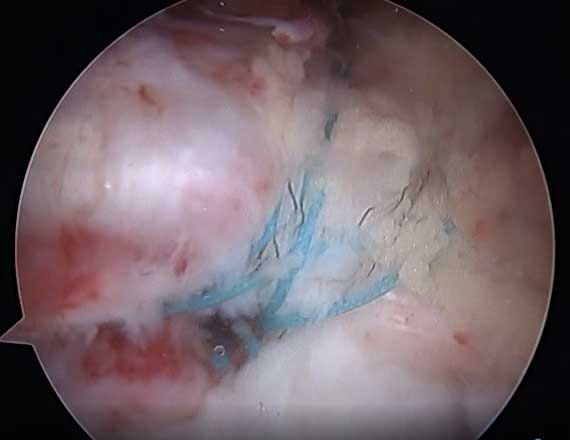
Torn Proximal Hamstring
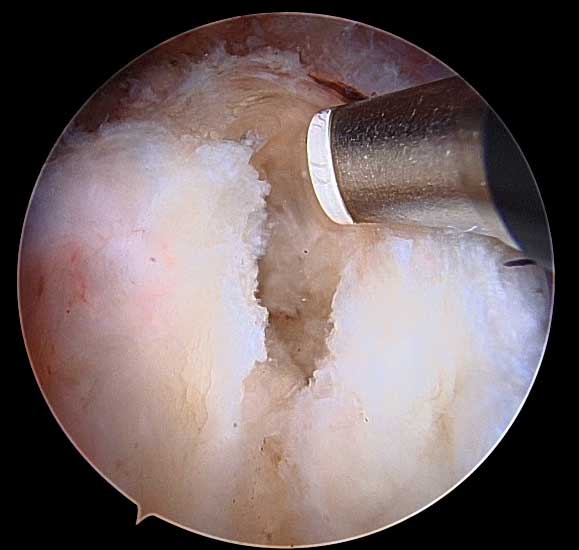
Proximal Hamstring Repair
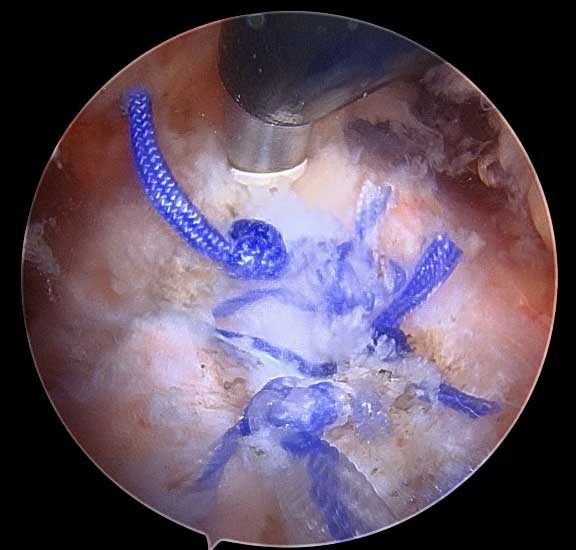
Contact Hip Arthroscopy Specialist Robert Browning, M.D.
Proximal Hamstring Tear
Posterior Hip Anatomy
- The hamstrings are made up of 3 strong muscles located on the posterior thigh (femur)
- The muscles form tendons on either side which attach to the lower knee (tibia) distally and the posterior pelvis (ischium) proximally.
- The hamstrings assist in bending your knee and straightening your hip
Watch this video for more information about hamstring tears.
What is a Proximal Hamstring Tear?
Proximal Hamstring Tears occurs when the hamstring tendons that attach to the posterior pelvis rip away from the bone, occasionally taking some bone with it
Common causes:
- Water Skiing
- Running
- Football
- Soccer
- Basketball
- Tennis
- Pickleball
Tears can involve one or both tendons and can be acute or chronic.
Proximal Hamstring Tear Presentation
- Active individuals of any age
- Patients typically complain of:
- Pain in the buttock and posterior thigh
- Pain with sitting and any activity
- Acute injuries will have bruising and swelling of posterior thigh
- It is important to seek out a hip preservation specialist if concerned about a tear as tears left untreated can cause long-term pain and dysfunction
Proximal Hamstring Tear Treatment
Key Concepts
- Not all patients with a proximal hamstring tear require surgery
- Small tears can improve with non-operative treatment
- Surgery is necessary for large tears and for smaller tears that have not improved with non-operative treatment
Non-operative Treatment for Proximal Hamstring Tears
- Reserved for small tears
- Rest and avoiding painful activities alone may improve symptoms
- Anti-inflammatory medicines (Advil, Aleve, etc.) and ultrasound-guided cortisone or PRP injections can decrease pain and inflammation
- Physical therapy can help improve pain and function
Operative Treatment for Proximal Hamstring Tears
- Minimally invasive surgery can be performed either through one small incision in the posterior thigh (as seen below) or through 3-4 poke hole incisions with the use of a camera and special instruments
- The tendons are reattached to the posterior pelvis (ischium) with suture anchors
- Patients return home the same day after surgery
- Patients are on crutches for 6 weeks
- Full recovery takes 5 to 6 months and requires PT to restore optimal hip and knee function
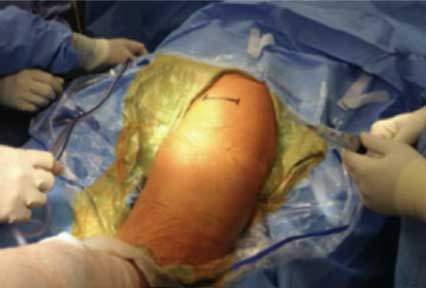
Hip Injury Treatment with Robert Browning, M.D. Hip Doctor in Columbia SC
Greater Trochanteric Pain Syndrome (GTPS)
Lateral Hip Anatomy
- The lateral hip is composed of muscles, tendons, and bursal sacs that overlay and attach onto the bony prominence on the outside of the hip (greater trochanter)
- The gluteus medius and minimus are muscles located on the outside of the hip. They are also called the “rotator cuff of the hip.” They form tendons that attach to the lateral hip and are essential for normal walking allowing your leg to swing to the side away from your body
- The iliotibial band (IT band) is a large band formed from two muscles that spans the outside part of the thigh and runs down to the outside of the knee
- The trochanteric bursa overlies the greater trochanter and provides cushion for the IT band and gluteus medius
What is Greater Trochanteric Pain Syndrome (GTPS)?
Lateral hip pain and dysfunction caused by the following:
- Inflammation in bursa caused by injury or overuse
- Patients typically complain of pain on outside of hip and thigh with direct pressure on outside of hip (i.e. sleeping on side) and pain when standing for a long time
Gluteus Medius Tears
- Increasingly recognized cause of GTPS (25% of middle-aged women)
- Tears can occur due to an acute injury or can result from repetitive stress and overuse
- Patients present with pain on outside of hip with sleep, standing, and going up and down stairs
- Larger tears can lead to a limp due to weakness caused by the tear
- Caused by thickening of the back part of the IT band
- The IT band then snaps across the bony prominence (greater trochanter) on the outside of the hip when moving the hip up and down
- Often can see the IT band snap but can’t hear it
- Bringing the leg across your body also causes pain and tightness
GTPS Treatment
Key Concepts
- Not all patients with GTPS need surgery
- Trochanteric bursitis and snapping hip often improve with non-operative treatment
- Surgery is necessary for large gluteus medius tears and smaller tears that fail non-operative treatment
Non-operative Treatment for GTPS
- Non-operative treatment is used in trochanteric bursitis, snapping hip, and small gluteus medius tears
- Rest, avoiding painful activities, and anti-inflammatory medications (Advil, Aleve, etc.) can often improve symptoms
- Physical therapy can help improve pain and function
- Ultrasound-guided cortisone or PRP injections can also be used to decrease pain and inflammation
Operative Treatment for GTPS
- Surgery is typically necessary for large gluteus medius tears or small tears that have not improved with non-operative treatment
- Minimally invasive surgery can be performed either through one small incision in the lateral hip or through 3-4 poke hole incisions with the use of a camera and special instruments
- The damaged trochanteric bursa is removed
- The tendons are reattached to the lateral hip (greater trochanter) with suture anchors
- Patients return home the same day after surgery
- Patients are on crutches for 6-8 weeks
- Full recovery takes 5 to 6 months and requires physical therapy to restore optimal hip and knee function
Torn gluteus medius

Glut Repair


